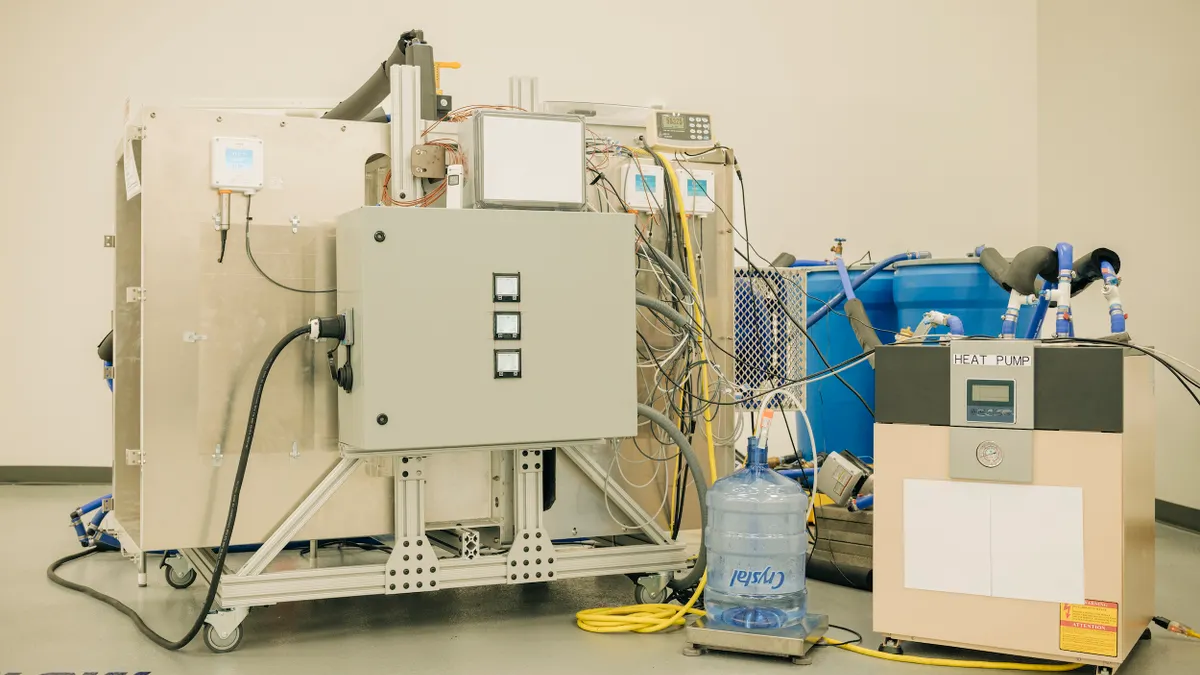The nation’s largest distributed energy show is turning into a software exhibition as utilities search for ways to make sense of a flood of data from new technologies on their grids.
“You used to have this tactile experience at DistrbuTECH where you could just hold the technology in your hands,” said Drew Johnston, director at Navigant Consulting. “Now it’s all behind the glass because it’s all digital.”
That observation was common last week in San Antonio at DistribuTECH, the annual conclave for distributed energy resources (DERs) in the United States. As in other industries, distributed energy vendors are shifting away from an early focus on hardware toward software solutions that can use those new technologies to improve grid performance.
“If you went to DistrbuTECH in the old days, it was like the hall of fame of smart meters — lots of hardware, people made it, there was a huge buildout going on all over the country,” said Mike Kanellos, a technology analyst at software vendor OSI Soft. “Slowly and gradually, it's becoming a software show. It's all people want to show and it's where they’re putting their investments.”
Part of that shift is because it’s difficult to make money on hardware solutions as a vendor, Kanellos, a former energy journalist, said.
“Hardware is a sisyphean task,” he said. “When you’re making hardware you’re actually sometimes defying laws of physics. Making a semiconductor, shrinking it every couple years following Moore's Law — it takes physics, material science, teams of engineers and it also takes billion-dollar facilities … Even if you’re a contract manufacturer, it's very complex and you need a lot of employees.”
Software companies, on the other hand, can be small and nimble, which can make it easier to find profitability in the crowded DER landscape. But the shift to software involves more than small companies. Even giant meter-makers like Itron and Landis+Gyr today situate their hardware as a part of a digital platform they say can help utilities improve reliability and cut power restoration costs.
“It's impacted our offerings,” Joel Sharrer, solutions and product strategy manager at Landis+Gyr, said. “We have not just the meters but we have a full suite of software consumer engagement tools that utilities can use.”
That industry-wide shift is due to a growing need at utilities to operationalize data coming from new grid technologies like smart meters, customer-sited generation and electric vehicle charging. While most utilities have at least some of these resources on their grids today, they are struggling to translate their deployment into tangible benefits for customers or system performance.
“It's all sensoring and data,” said John Zahurancik, COO at Fluence, a storage company founded last year by AES and Siemens. “Then to make any sense or use of it you’re going to have to do some kind of software management of it and react to things — software plus AI and machine learning, probably.”
That grid management issue is the sticking point today for distributed energy, sector insiders said. DERs hold the potential to revolutionize the power sector, deferring or replacing massive infrastructure projects that defined the industry for a century. But to realize that goal, utilities first need new tools and processes to control the diverse resources.
“I see a lot more focus on software solutions for managing the grid — how are we going to keep the grid reliable and safe?” said Sharon Allan, chief innovation officer at the Smart Electric Power Alliance, a nonprofit that works with utilities to integrate clean energy. “This year seems to be the year of the grid is my takeaway.”
DERMS — the key to control
The focus on utility control software at DistribuTECH this year was not always a given. Only a few years ago, some sector observers worried DERs could spark a “death spiral” for regulated utilities as increasing amounts of consumer demand are served by alternative suppliers.
But now, there’s a “shift in the mindset,” said Sameer Kalra, principal for smart grid technology and product innovation at Pacific Gas and Electric.
“People used to talk about the death of the utility, but things have changed because people realize utilities have a role to play,” he said. “Now I think the grid reliability is the key role for the utility.”
Learning how DERs can enhance that reliability was a key goal of PG&E’s recent energy storage pilot that tested how the utility can interact with residential storage from Tesla as well as C&I batteries from Green Charge Networks, Kalra said. The key lesson from that and other DER pilots was that the utility needs a more sophisticated software platform to help it control DERs — a Distributed Energy Management System, or DERMS.
DERMS will help [distributed resources] get to the capacity market

Sameer Kalra
Principal, PG&E
Today, most utilities control DERs with their existing distribution management software, “bootstrapping” the new resources on top of the legacy system, SEPA's Allan said. But in California, pushed by DER growth and regulatory requirements, the state’s big three investor-owned utilities are experimenting with DERMS that give them more visibility and control into the resources.
It’s these new software platforms that Kalra and many others say may hold the key to realizing the potential for DERs to act as bulk power resources, providing grid services usually reserved for large power plants.
“The key thing is that DERMS will help us get to the capacity market,” he said. “The voltage support and all the capacity — that's a possibility.”
California’s regulatory rules stipulate that utilities like PG&E assess DERs as an alternative when making any traditional power system investments. DERMS could also make these non-wire alternatives more viable in the future, Kalra said.
“We have been asked ... every time you do a substation upgrade to look at DERs [as an alternative],” he said. “Our planning team is now looking at that as an option. Previously it was not an option.”
DERMs development
It’s still early days for DERMS deployment, Kalra and Allan stressed, and the sector so far even lacks a common definition of what one is. The other California IOUs — Southern California Edison and San Diego Gas & Electric — and some Canadian utilities also have DERMS pilots in action, but no North American utility has fully integrated one into their larger power control system.
Before DistribuTECH, Allan’s organization, SEPA, convened its utility and vendor members for meetings to better define the attributes and requirements of DERMS. The goal, she said, is to find common requirements for the software platforms so vendors can design them for utilities throughout the world, not just for the California market.
“What we’ve been seeing in the group is we have a number of investor owned utilities who are there listening, absorbing, because so many of the Californians are on the front edge,” Allan said. “Now we've got some lessons learned and we're trying to shape requirements so it makes it easier when you’re sourcing this.”
Jason Handley, director of smart grid operations at Duke Energy, said his company is looking for systems that can do more than just integrate DERs reliably.
“DERMS systems that are available today from what I've seen are usable but I don't think they’re exactly where we need them to be yet,” he said. “We need to prepare ourselves for more than just integration, but for a world where consumers are buying and selling energy to each other through transactive energy. Does the DERMS system allow for that? In most cases, nobody's thinking about that yet.”
That transactive energy future is likely still years away, and many utilities are skeptical that significant numbers of consumers will ever be conducting peer-to-peer electricity trading. But some DERMS pilots are already showing how customer-sited resources can interact with utility control systems in real time, a precursor to any major transactive energy scheme.
DERMS integration with [distribution control systems] will become run-of-the-mill, mainstream implementation

Neetika Sathe
Director of Emerging Technology, Alectra Utilities
Alectra Utilities, formed last year by the merger of four municipal utilities outside of Toronto, is currently demonstrating a DERMS platform from vendor Enbala as a part of its Cityview Microgrid pilot and also has a residential virtual power plant demonstration in operation.
At the microgrid, Enbala’s platform sits atop control systems for a number of resources, including solar, battery storage, electric vehicle charging and a natural gas generator, said Neetika Sathe, director of advanced planning at Alectra. The control systems for these individual resources “talk” to Enbala’s DERMS platform.
Eventually, Sathe and Kalra envision a system where these multiple layers of control systems communicate with a central utility DERMS. The utility DERMS would then communicate with older distribution management and outage control software at the utility to optimize its system.
“There will be a multiple hierarchy of DERMS,” Kalra said. “There will be a utility DERMS and there will be an aggregator DERMS next to it ... [Resource] optimization is part of it and the other is managing and dispatching the DERS, so that can happen at different levels depending on the size of the DERs.”
But while the Cityview project is showing encouraging results, Sathe said Alectra has yet to integrate DERMS into its full utility operation system. To do that, she said the utility will need a system that can integrate both load curtailment assets like intelligent thermostats and EVs, as well as generation and energy storage.
“The power of aggregation comes from being diversified, so we should be able to harness the power of the diversified fleet whether it is one-directional which is load curtailment, or bi-directional which is solar and storage,” Sathe said. “The other requirements is in terms of automation [the DERMS] can take multiple signals, whether it is [grid operator] signals, pricing triggers or greenhouse gas emission triggers.”
The key, utility officials agreed, is that emerging DERMS platforms not only perform these functions, but be adaptable enough to meet multiple grid objectives depending on a utility’s needs. Those demands may seem steep for a technology in the nascent stages of development, but Sathe expects DERMS to follow a similar development pattern to Advanced Distribution Management Systems (ADMS) and Fault Detection, Isolation and Restoration (FDIR) software. Both were thought of as futuristic a few years ago, but now are integral parts of the utility control room.
“It's still very much in a nascent stage of learning, but if the solutions seem easy to implement within a few years, this will become what ADMS was years ago,” Sathe said. “ADMS was a pilot. Automating the grid — FDIR — was very much a pilot. Today it's in deployment, so it's gone through that cycle. ADMS is going through that cycle and next DERMS integration with ADMS will become run-of-the-mill, mainstream implementation.”
Correction: A previous version of this article indicated the Enbala DERMS platform at Alectra's Cityview Microgrid communicated with Alectra's central distribution control system. The microgrid platform communicates with control software for its individual resources, but is not presently tied to the utility's distribution control system.


















